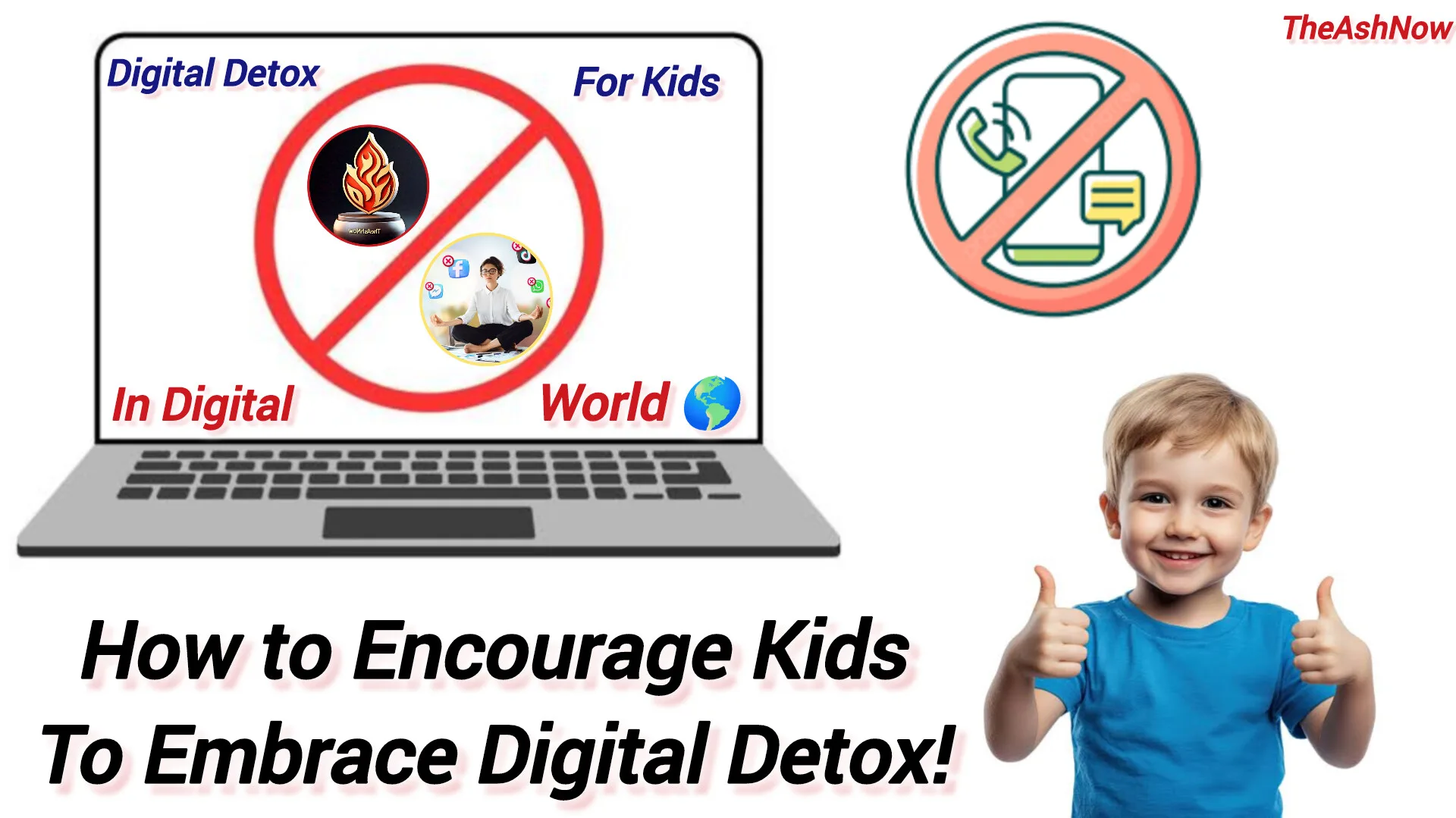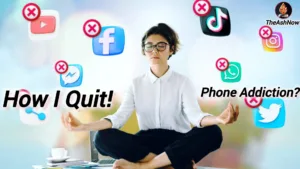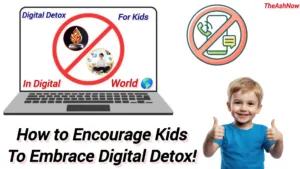Embrace Digital Detox: In a world where screens are virtually inescapable, “digital detox” isn’t just trendy—it’s necessary. For kids growing up in the United States, technology is an educational tool and a default leisure activity. From YouTube videos and mobile games to online classrooms and virtual playdates, screen time has become more of a lifestyle than a choice.
However, excessive screen exposure can impact children’s mental health, sleep patterns, social skills, and even academic performance. As parents, educators, and caregivers, the challenge lies in encouraging children to step away from screens without turning it into a battle. Let’s explore how to guide kids into embracing digital detox, not as punishment but as a positive lifestyle habit.
Table of Contents
Table of Contents

Why Digital Detox for Kids Is Essential
Before diving into how, it’s crucial to understand why digital detox matters:
- Mental Health Concerns: Studies show that prolonged screen time may increase the risks of anxiety, depression, and attention problems in children.
- Physical Issues: Eye strain, poor posture, and disrupted sleep cycles are common.
- Stunted Social Skills: Face-to-face interaction is critical for emotional intelligence and development.
- Dependency: Over-reliance on screens for entertainment or comfort may lead to tech addiction at an early age.
1. Start with Family Awareness and Involvement
Digital detox starts at home. Children observe and mimic adult behaviors, so parents need to lead by example.
- Host a family meeting to talk about screen time and its pros and cons.
- Create a digital wellness plan that includes everyone, from toddlers to teens and adults.
- Discuss openly how screens affect feelings, relationships, and health.
💡 Tip: Use visual charts or infographics to show kids how much time is being spent on screens each day versus playing outside or reading.

2. Establish Tech-Free Zones and Hours
Creating consistent boundaries helps children develop a healthy relationship with digital devices.
- Tech-Free Zones: Designate areas such as the dining table, bedrooms, or family lounges as no-device zones.
- Tech-Free Hours: Establish certain hours, like during meals, one hour before bedtime, or Sunday afternoon, as screen-free time.
🛏️ Why it works: Removing screens before bed improves sleep quality and mental rest.
3. Offer Engaging Alternatives to Screen Time
One reason kids get hooked on screens is that there’s nothing else more interesting. Replace screen time with activities that are fun, stimulating, and interactive.
Offline Activities Kids Can Enjoy:
- Board games and card games
- Gardening or DIY crafts
- Storytelling or reading sessions
- Outdoor sports and biking
- Nature walks or picnics
- Cooking or baking together
🌻 Pro Tip: Let the child choose the activity—it gives them a sense of control and excitement.
4. Gamify the Digital Detox
Turn digital detox into a challenge or game. Kids respond better to activities when they’re made fun and rewarding.
Ideas:
- Detox Chart: Reward stars for every tech-free hour.
- Weekly Challenge: “Can you stay off screens for 2 hours today and build a Lego castle instead?”
- Detox Jar: Pick a non-screen activity from a jar and complete it together.
🏆 Rewards can include a movie night (offline), choosing dinner, or a family outing.
5. Use Technology Wisely (and Selectively)
Digital detox doesn’t mean rejecting all forms of technology. Teach children to differentiate between passive and active screen time.
- Passive: Binge-watching cartoons or scrolling social media
- Active: Online learning, educational apps, creative digital art tools
Encourage the use of tech for learning and creation rather than consumption alone. Guide them to use apps that promote critical thinking, problem-solving, and creativity.
6. Educate Through Real-Life Examples
Use storytelling or current events to help kids understand the long-term effects of excessive screen time.
Examples:
- Share stories of kids who improved grades and health after limiting screen use.
- Discuss how famous entrepreneurs or athletes balance screen time with real-world activities.
- Watch documentaries or short videos (ironically, yes) on digital detox and discuss them afterward.
7. Encourage Social Interaction in Real Life
Screens can give the illusion of connection, but real bonding happens in person.
- Arrange playdates, nature camps, or family gatherings.
- Enroll your child in a group activity, like art class, music lessons, or martial arts.
- Encourage them to participate in community events, volunteering, or local clubs.
🤝 Face-to-face interaction helps develop empathy, confidence, and communication skills.
8. Balance, Not Ban
Going completely screen-free may lead to rebellion or frustration. The goal is to teach balance, not enforce control.
- Allow occasional screen time, but with guidelines and purpose.
- Practice “digital sabbath”—one day per week with limited tech.
- Use screen time tracking tools like Apple’s Screen Time, Google Family Link, or third-party apps like Qustodio to monitor and adjust.
9. Open Dialogue and Emotional Support
A digital detox should never feel like punishment. Be empathetic and supportive throughout the process.
- Ask your child how they feel after less screen time—tired? Refreshed? Bored?
- Help them reflect on how offline activities affect their mood.
- Reassure them that it’s okay to feel bored—boredom can be the seed of creativity.
10. Create a Long-Term Habit with Reflection
Once your child starts enjoying digital-free time, make it a long-term lifestyle.
- Use a weekly reflection journal where they can jot down what they did and how they felt.
- Involve them in planning activities for the next detox day.
- Celebrate digital detox milestones—like one week of reduced screen time.
📓 Keeping a reflection log can help both kids and parents see progress and value in the journey.
Final Thoughts: A Healthier, Happier Childhood Without Screens
Helping children embrace a digital detox isn’t about disconnecting from technology altogether—it’s about reconnecting with life beyond the screen. By setting the right example, offering meaningful alternatives, and maintaining open communication, we can help our kids rediscover joy in the real world, where their imagination, curiosity, and creativity can thrive.
Let the digital detox begin—one screen-free hour at a time.
💬 What’s Your Digital Detox Strategy? Please Comment Below👇
Have you tried a digital detox with your kids? What worked and what didn’t? Share your experience in the comments below. Let’s build a healthier digital culture together.
Here are 10 high-level FAQs
1. How can parents differentiate between productive and passive screen time when evaluating a child’s digital habits?
Answer: Productive screen time includes activities that stimulate creativity, learning, or meaningful social interaction, like coding, digital drawing, or language apps. Passive screen time involves scrolling, binge-watching, or idle gaming. The key is evaluating intent, outcome, and emotional response after usage. If the child feels energized, inspired, or connected, it’s likely productive.
2. In what ways can digital detox improve cognitive development and emotional intelligence in children?
Answer: Reducing screen time allows the brain to engage in deeper thought processes, enhancing focus, memory, and imagination. Offline experiences promote empathy through real-world interactions, improve emotional regulation by reducing overstimulation, and strengthen executive functions like decision-making and delayed gratification.
3. How can parents create a digital detox strategy without triggering resistance or rebellion in older children or teens?
Answer: Collaborative goal-setting is essential. Instead of enforcing top-down rules, involve teens in the planning—ask them what screen habits they’d like to change and why. Introduce detox as a mental health strategy, not a punishment. Emphasize balance, not restriction, and always offer engaging offline alternatives.
4. What long-term psychological risks are associated with children growing up without regular digital detox practices?
Answer: Chronic screen overuse can contribute to attention disorders, anxiety, depression, social isolation, and low emotional resilience. Over time, it may reduce creativity, impair real-world communication skills, and create dependency on dopamine hits from digital feedback, leading to addictive behaviors.
5. How can digital detox be embedded into a child’s daily routine without feeling disruptive to their lifestyle?
Answer: Integrate digital detox subtly into natural transitions—like mornings, mealtimes, and bedtime. Use tech-free rituals such as reading before bed, nature walks after school, or analog hobbies on weekends. When consistent and enjoyable, these routines become part of the child’s lifestyle instead of feeling like a chore.
6. What role should schools and educators play in promoting digital detox among students?
Answer: Schools can model balanced tech use by limiting unnecessary screen time, encouraging handwriting, and assigning real-world projects. Educators can teach digital literacy and self-regulation, promote screen-free group activities, and partner with parents for consistent messaging around mindful tech use.
7. How can families reframe boredom as a developmental opportunity rather than something to avoid with screens?
Answer: Boredom is a launchpad for creativity. Parents can teach children to see boredom as a signal to invent, explore, or reflect. By resisting the urge to entertain them constantly, families encourage problem-solving, self-directed play, and imaginative thinking—critical skills for lifelong learning.
8. Are there neurological studies supporting the benefits of screen reduction for children’s brain development?
Answer: Yes. Studies from institutions like NIH and the University of California have shown that excessive screen exposure can alter brain structure, especially in areas responsible for language, attention, and impulse control. Reduced screen time is linked to improved sleep, brain plasticity, and better academic performance.
9. How can technology be leveraged to support digital detox instead of undermining it?
Answer: Use tech tools like parental control apps, screen trackers, and wellness reminders to encourage balance. Educational apps can guide kids to use tech purposefully. Devices with digital wellbeing features (like Apple Screen Time or Android’s Digital Wellbeing) help create awareness and accountability.
10. What indicators should parents watch for that signal a child might need an urgent digital detox?
Answer: Warning signs include:
Increased irritability when screens are removed.
Sleep disturbances or fatigue.
Decline in academic or physical activity.
Avoidance of real-world social interaction.
Dependence on digital approval (likes/comments).
Loss of interest in once-loved hobbies.
When multiple signs appear consistently, it’s time for a structured detox strategy—ideally guided by both family and, if needed, a child psychologist.
Read More:









Very energetic blog, I liked that a lot. Will there be a part 2?
my site: Nordvpn Coupons Inspiresensation (http://T.Co/)